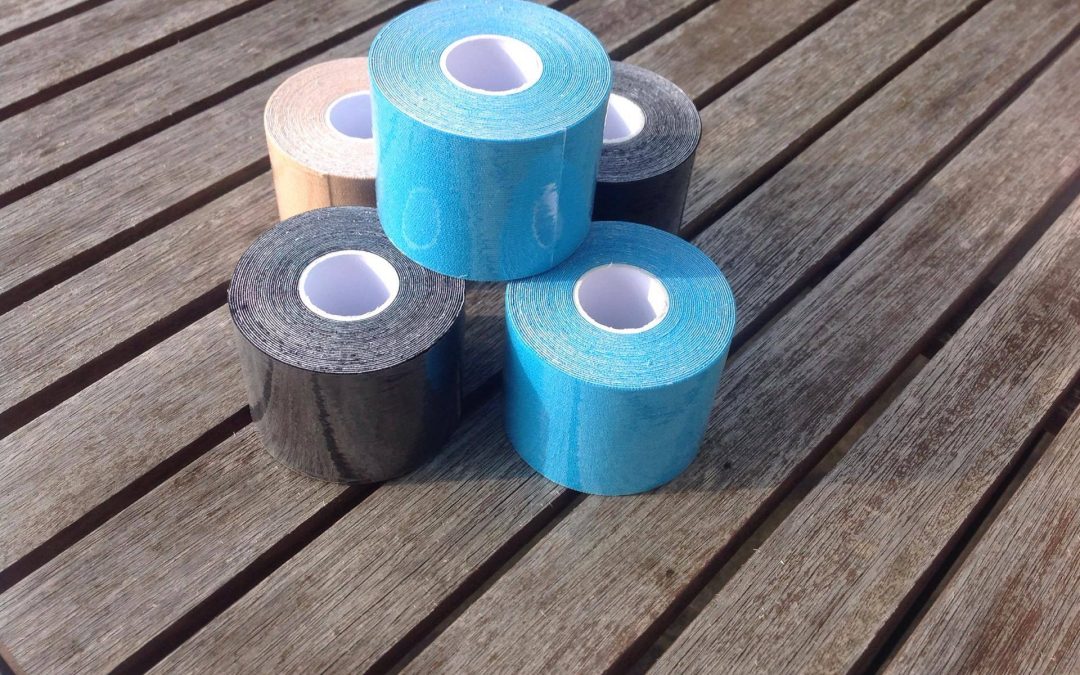Kinesio Tape or Kinesio Tex Tape is a modality that has been around for quite some time. It was developed in Japan by Dr. Kenzo Kase, a chiropractor, in 1973 after his trials and errors using other adhesive tapes that were commercially available at the time. This tape is made from a blend of polymer elastic strands or nylon, and cotton, water-resistant very flexible material that mimics the elasticity of skin so wearing this will not restrict movements and ranges of motion, which makes it different to the traditional athletic strapping techniques, as these are more restrictive and are usually taken out after their intended use, like the end of an athletic event.
This method of taping is a rehabilitative taping technique that can help speed up the body’s natural healing process for a couple of different systems. These are worn around the joints, more commonly the knees, to provide added support. Other systems include: the circulatory system, the neural system, the muscular system, and orthopedic systems.
Therapists are using this tape for altering the tones of muscle, shifting or draining the lymphatic fluids, and even improving posture. This is done by wrapping said tape around these systems that need the most help. Some conveniences of this tape include the very low price range than other quantities of tape and garments that are said to do the same thing. They are also easy to wear and can be worn over longer periods of time, usually over a period of days.
Kinesio Tape, despite its flexibility, is also able to stabilize the muscles and aid in proprioception. This is the awareness of muscle engagement. Because of this, Kinesio Tape is used by physiotherapists, occupational therapists, manual therapists, nurses, physicians trainers, athletes, and chiropractors like Dr. Kase himself – although a majority of non-athletes have also adapted to using these tapes.
Common uses for Kinesio Tape are:
- Treating Injuries – Kinesiology can help with alleviating pain and minimize swelling, but only as an addition and not the main treatment.
- Supporting Weaker Areas – Kinesio Tape can be wrapped around muscles or joints that may need rehabilitation including:
- IT band injuries (iliotibial band syndrome) which involve knee pain
- Hamstring injuries
- Achilles tendonitis (pain at the back of the ankle or lower calf)
- Shin splints (medial tibial stress syndrome) which involves inflammation around the tibia Rotator cuff injuries (scapula to humerus area)
- Tennis elbow (lateral epicondylitis) affecting tendons in the wrist and fingers, down to the epicondyle
- Plantar fasciitis or heel pain
- Training/Altering Muscles – The tape can help muscles that have taken on a more unhealthy way of working. This can also help improve posture and position, like in the head and neck.
- Improved Performance – Athletes wear these to help achieve maximum performance levels, these are commonly seen being worn by volleyball players, as well as runners. It is worn to help prevent injuries while training and competing, as well as to wake up certain muscles to work them.
- Scar Appearance – Some studies suggest that wearing Kinesio Tape, while not advised to be worn on open wounds, they can eventually improve the appearance of scars over time.
Evaluation of one’s present medical conditions and needs will help you understand which areas to treat and if you can even use Kinesio Tape at all. A full assessment by a medical professional would be needed before use because Kinesio Tape can also be harmful to the following:
- Deep Vein Thrombosis (DVT) – Kinesio Tape increases mobility and blood/fluid flow could possibly cause blood clots to dislodge and can even be fatal if this leads to a pulmonary embolism which is a blockage of arteries in the lungs.
- Lymph Node removal – Increased blood/fluid flow can when a node has been removed can potentially cause swelling.
- Diabetes – Persons suffering from diabetic conditions can also experience peripheral neuropathy which is a condition where there is altered sensation in the legs or arms, which can also cause numbness to the effect the tape has on the body.
- Open wounds – Tape can potentially cause the growth of bacteria to enter the wound causing an infection.
- Active cancer – An increase in blow flow can be hazardous to those undergoing cancer treatments.
- Allergic reactions – Those that are allergic to adhesive will experience discomfort as Kinesio Tape is worn sometimes for days at a time which can cause the skin to react and an allergy to develop.
Kinesio tapes are applied in X, Y, I, and cross patterns depending on your need and goal. While Kinesio Tape claims to have a lengthy list of benefits, always keep in mind that it is best to get to the root of your pain or discomfort, if experiencing any. Kinesio Tape is used to aid and assist but not solve the entire problem.
Image “Kinesio Tapes” by MipMed is licensed under CC BY 2.0


